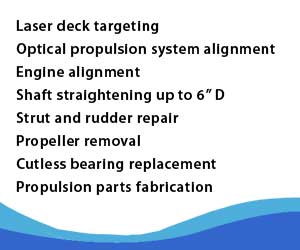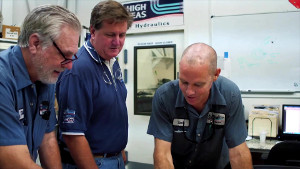Building Lloyd’s Certified New Shafts
When working on Lloyd’s Register classification vessels, stringent rules apply to what can and can’t be done on certain aspects of the boats. More importantly, Machine Shops and their machinist must be properly certified to perform the work. Straight Line Marine, located at the Lauderdale Marine Center, holds all applicable certifications to work on these classes of boats. Straight Line Marine is a division of High Seas Yacht Service and along with the High Seas Hydraulics division, the three companies can perform a wide range of services all under one roof.
A 1988 145 foot NQEA, with six shafts and four SKF hydraulic muff couplers, needed two main shafts replaced because they were worn and pitted. The two main shafts were the final shafts that connect to the engine. Because this yacht is Lloyd’s classified, standard shaft cladding repairs were not an option.
In order to fabricate the new shafts, we used Duplex 2250 stainless steel materials which are used extensively in applications that require good corrosion resistance and strength. More importantly, this material is certified for use in Lloyd’s classified vessels.
The purchased material was 5 inches in diameter but was sent to a centerless grinder to grind the material down to 125mm to match the old shafts. Centerless grinding is a machining process that uses abrasive cutting to remove material from the shaft. Centerless grinding differs from centered grinding operations in that no spindle or fixture is used to locate and secure the shaft which is secured between two rotary grinding wheels, and the speed of their rotation relative to each other determines the rate at which material is removed from the shaft. Other than this process, all other machining was performed in our shop at Straight Line Marine
Another part of the Lloyd’s process is tracing the “heat” number. This is a number that is stamped on the end of the shaft at the original foundry. The material gets a “Quality Assurance Certificate of Test” that outlines the materials metallurgical composition along with tensile and Rockwell strength measurements. Once the fabrication process was complete, the “heat” number is again stamped on the end of the cleanly machined new shaft. This is a requirement from Lloyd’s to enable them to track the material from foundry to vessel and ensure compliance.
The final step in the process is to do a red dye penetrant crack test on the key ways and tapers. Red dye crack tests are used to detect casting, forging and welding surface defects such as hairline cracks, surface porosity, leaks in new products, and fatigue cracks on in-service components.
Lloyd’s requires that this process be completed by a Level II certified crack test technician. Our lead machinist, Chris Z. holds this designation and is qualified to perform the work.
When you required work on a Lloyd’s classified vessel, it is important to hire Lloyd’s certified technicians or risk losing the classification on the yacht and all the benefits that go with it.




 Click to watch the video of a day at High Seas Yacht Service.
Click to watch the video of a day at High Seas Yacht Service. Click to watch Marine Industries Association of South Florida video featuring Salty Jobs at High Seas Services.
Click to watch Marine Industries Association of South Florida video featuring Salty Jobs at High Seas Services.
Comments are closed.